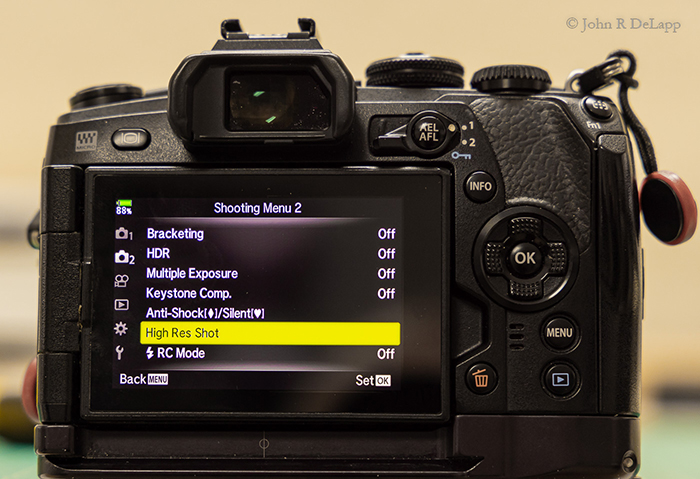By John R. DeLapp
What is Pixel Shift?
If you own a camera that has a “high resolution” option, your camera uses pixel shift to boost the native resolution to a higher level. The term “pixel shift” is a bit misleading – the pixels don’t move – only the sensor holding the pixels moves. In high-res mode the camera shoots multiple images while a series of pixel shifts takes place as the camera’s sensor moves in a designed pattern to enhance the image. Depending on the camera and resolution desired, 4, 8, or 16 images are taken and composited in-camera making a final image; or in the case of Sony and Fujifilm, composited using external software. I believe Olympus was the first company to offer this high-res feature and several others have followed suit (my search revealed cameras in the list below have a high-res feature). Using pixel shift requires the subject to be stationary and the camera locked down on a solid tripod. One exception to the tripod requirement are two Olympus cameras (shown below) which have a high-res system that is designed for handholding, although use of a tripod is recommended for best results. A graphic view of the pixel shift process and more information on how it works can be found here.
Is High Res Useful?
Given that some of the newer digital cameras have native resolutions of 45, 50, 61, or more megapixels, I wonder if any higher resolutions are needed for most photographers. If you make extra-large prints, anticipate large cropping of the image, or do studio work, then sure, it might make sense to use pixel shift to increase the resolution. Instead of using the high-res function, some might choose to upsize the native image in post processing with software, such as Topaz Gigapixel. But this method has limitations and will not match the boost to resolution and image quality that is provided by pixel shift. In addition to increasing image resolution and detail, pixel shift improves color clarity, dynamic range, and reduces digital noise.
Are There Drawbacks to Using Pixel Shift?
- Subject must be stationary.
- Camera must be stationary (except for the Olympus E-M1-III, E-M1-X).
- Camera can’t be used while compositing the images (a few seconds to 15 seconds).
- Huge files could be difficult to process and use more computer storage.
- Sony and Fujifilm cameras require external software for high-res compositing.
- Some cameras have limits on ISO and f-stop settings in high-res mode.
- Flickering lights may impact the image.
- Use of electronic flash on some cameras is not possible.
Cameras With High-Res Functions
Olympus:
- E-M1-II, 20 MP sensor (micro4/3), high-res 50 MP, or 80 MP.
- E-M1-III, & E-M1-X, 20 MP sensor (micro 4/3), high-res 50 MP hand, 80 MP tripod.
- E-M5_III, 20 MP sensor (micro 4/3), high-res 50 MP.
Sony:
- a7R-III, 42 MP sensor (full frame), high-res 170 MP.
- a7R-IV, & a7R-V, 61 MP sensor (full frame), high-res 240 MP.
- a1, 50 MP sensor (full frame), high-res 199 MP.
Panasonic Lumix:
- S1, 24 MP sensor (full frame), high-res 96 MP.
- S1R, 47 MP sensor, (full frame), high-res 187 MP.
- G9, 20 MP sensor, (micro 4/3), high-res, 80 MP.
Pentax:
- K-1-II, 36 MP sensor (full frame), high-res 300 MP.
Fujifilm:
- GFX 100 & 100S, 102 MP sensor (med. format), high-res 400 MP-DNG file.
Final Thoughts & Feedback
Let me know if there are any other cameras that I may have missed that have a high-res feature. So far, it appears that no Nikon or Canon cameras have this feature. Also, I have only used the high-res system in my Olympus E-M1-II camera a few times to test it, so I’d be interested in hearing your experiences, if any, with using the high-res feature in your photography.

